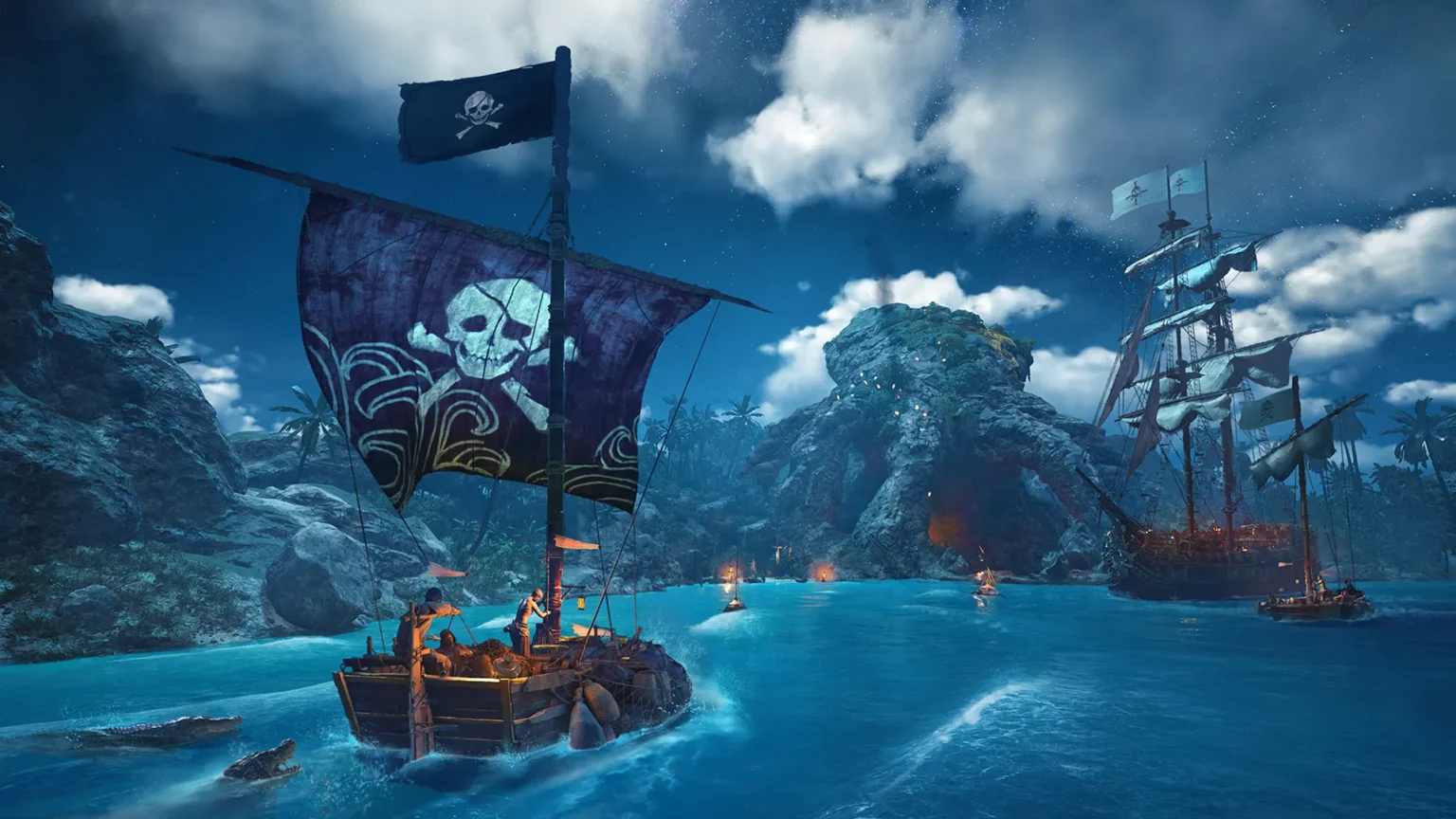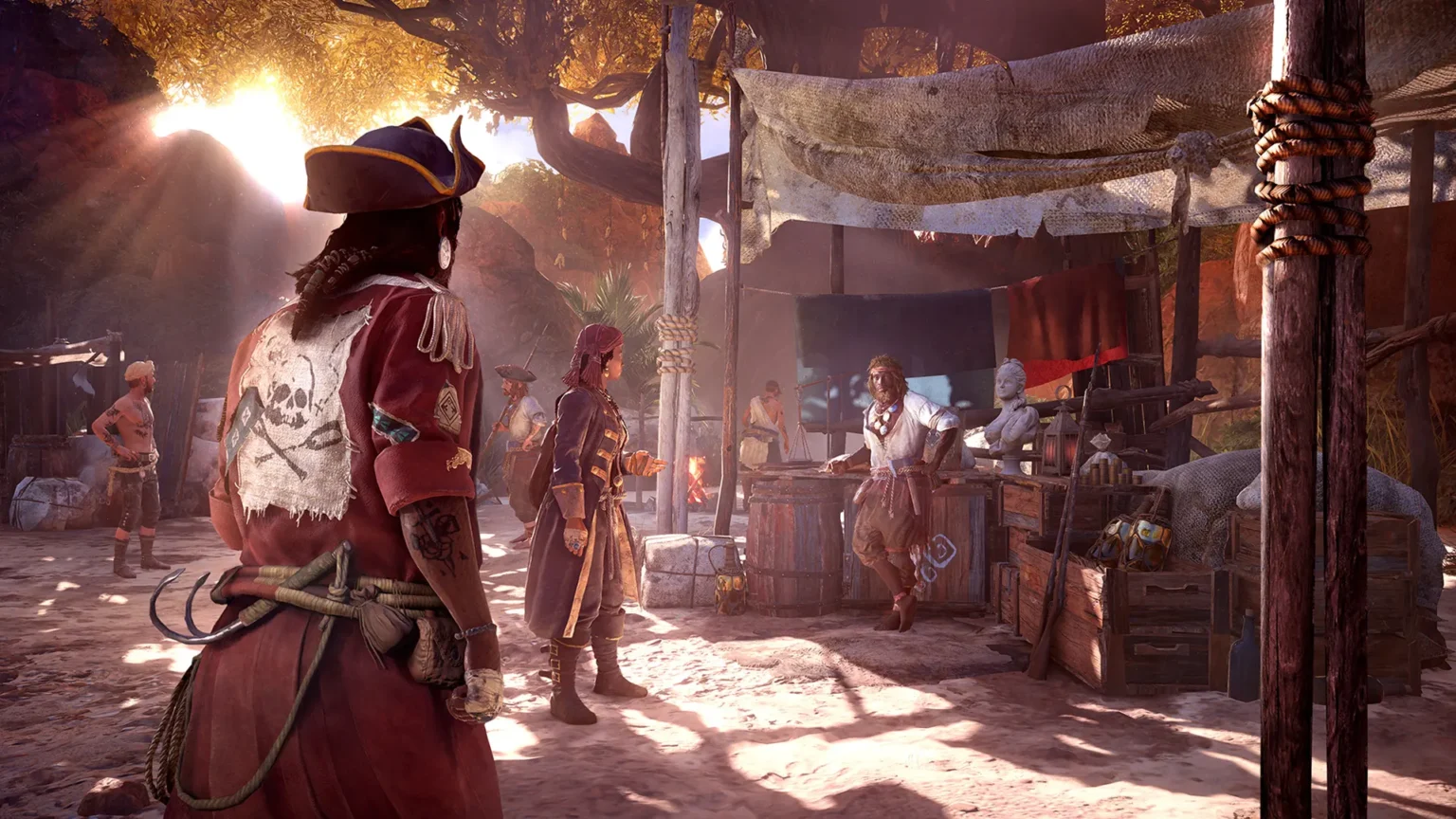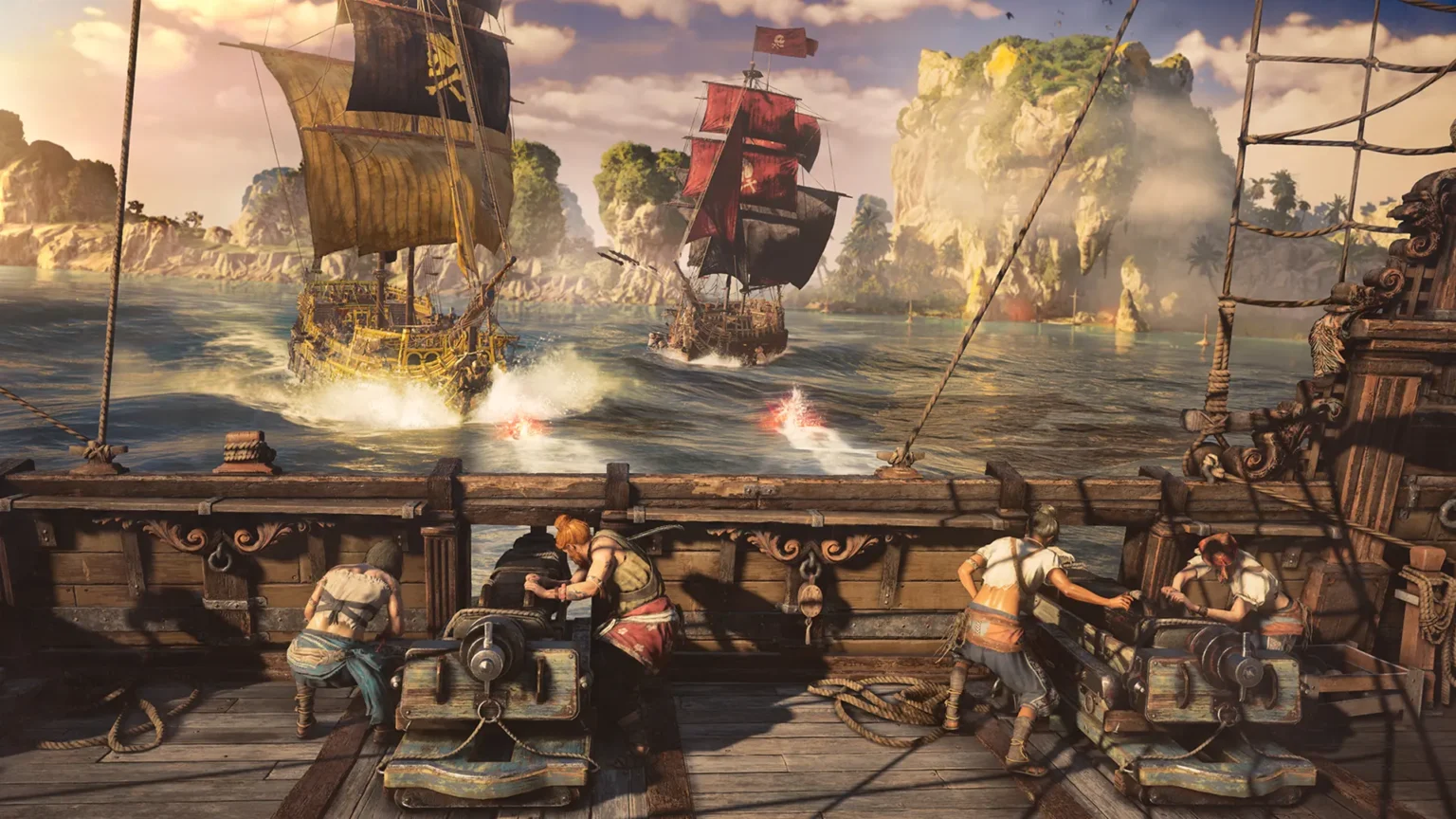After its initial announcement at the E3 conference in 2017, the moment has finally arrived after 7 years to delve into the exhilarating world of Skull and Bones. As a fan of Assassin’s Creed Black Flag, renowned for its stellar naval battles, I eagerly anticipate whether Skull and Bones can replicate that same level of enjoyment. Nonetheless, the time has come to ready ourselves to command the seas in the realm of Skull and Bones. But without further ado, let’s swiftly commence the review and evaluation of the Skull and Bones game.
Skull and Bones
- Gene: Adventures, Action
- Play Styles: Single Play | Online
- Release date: February 16, 2024
- Review device: PlayStation 5
- Developer: Ubisoft Singapore
- Publisher: Ubisoft
- Age rating: 18
- Available on: Xbox Series X|S, PlayStation 5, PlayStation 4, PC
The Pirates
The game boasts an expansive map teeming with activities, allowing players to freely explore or engage in main quests, side quests, or open-world activities. Divided into four distinct regions—The Red Isle, Coast of Africa, Open Seas, and East Indies—each area offers its own unique attractions and activities. For instance, The Red Isle is characterized by its isolated landscape adorned with vibrant red soil and colorful mountains.
Furthermore, the game world is governed by influential pirate kings, with power consolidated among four primary factions: Ungwana, Clan of Fara, Dominion of Rempah, and Sea People. However, the seas are also frequented by three major trading companies, viewed as adversaries by pirates due to the plundering of their trade. These companies include Compagnie Royale, Dutch Merchant Company, and British Trade Alliance.
The Story
In the realm of online games, the main storyline often takes a back seat, yet Skull and Bones presents a narrative that holds some merit. Upon commencing the game, players find themselves thrust into the midst of a pivotal battle, which culminates in the destruction of their vessel, leaving them stranded. However, fortune smiles upon them as they soon encounter potential allies who propose the ambitious endeavor of crafting their own ship and assuming the mantle of captaincy. After gathering the requisite resources, players set sail on their personal voyage into the pirate-infested waters, with aspirations of attaining the notorious reputation of the most fearsome pirate in the game world.
At the onset, players are granted the opportunity to fashion their own character to their liking, a customary feature in such games. Offering ample options for customization, players can personalize their pirate avatar with a variety of clothing and accessories, distinguishing themselves amidst the seafaring populace. Advancing through the story and accruing resources through plundering endeavors enables players to amass the wealth necessary to indulge in enhancing their character’s appearance.
Missions and Events
The game boasts an abundance of quests that demand a considerable investment of time to complete, spanning main missions, side contracts, and open-world activities. Players who participated in the recent open beta experienced firsthand the vast content the game has to offer. Let’s delve into the main missions, dubbed “Deals,” which commence under the guidance of John Scurlock, a prominent figure in the pirate hierarchy. Working under his command, players undertake tasks that contribute to their notoriety. Subsequently, tasks transition to another influential pirate, Admiral Rahma, whose patronage further elevates players’ reputation. As notoriety mounts, players will notice its impact reflected in interactions with NPCs throughout the game world, receiving greetings and accolades.
Contracts, on the other hand, are smaller tasks designed to bolster players’ reputation. What sets these tasks apart are the rewards they yield upon completion. These rewards often include blueprints for upgrading weapons and tools, enhancing both the appearance and performance of the player’s ship. Contracts can be procured from select NPCs scattered throughout the game world or from merchants.
Furthermore, the game introduces the Bounty Board, a unique feature found in select dens throughout the game world. These boards announce substantial rewards for those brave enough to eliminate notorious pirate leaders. Each leader possesses distinct characteristics, contributing to the richness of the game experience. Additionally, players can access the Job Board to acquire additional tasks of varying difficulty levels, offering opportunities to uncover new challenges and reap exciting rewards.
Additionally, the game features interactive activities within its open-world map, fostering collaboration or competition among players on the same server. These activities, visible on the game map, offer opportunities for cooperative or competitive engagement. However, the activity system exhibits some randomness, evidenced by instances such as chasing down pirates located at the map’s farthest end, enabling them to escape before players could intercept them. This aspect requires refinement to enhance organization and elevate the overall gaming experience.
Transitioning from the unique aspects of the quest system, let’s address some notable shortcomings encountered during gameplay. A significant drawback pertains to the map’s leveling system, which necessitates leveling up one’s ship to access certain areas. Failure to do so may result in encountering higher-level ships capable of overpowering the player easily. In missions requiring long-distance travel, piloting ships of an advanced level may present situations where players are compelled to flee rather than confront, leading to feelings of frustration and diminished enjoyment.
Furthermore, a notable inconvenience arises from the frequent necessity to return to the task-receiving location upon completing a task, whether it’s a main or side task. This requires traversing long distances to inform the task owner of one’s achievement and claim the reward. Initially, this may seem mundane, but over time, it can devolve into a tedious and repetitive chore, negatively impacting the overall gaming experience.
As players progress through the main quests, they gain access to a new opportunity: engaging in the production and sale of goods. This involves selecting suitable trades, manufacturing desired products, and subsequently selling them to merchants. However, players must exercise caution during product transportation, as they may encounter enemies intent on stealing their shipments.
The Ship
Having provided a comprehensive overview in this review, let’s delve into the evaluation of the ship, a fundamental element of the gaming experience. However, it’s important to note that the assessment of the ship tends to lean toward the negative side.
In Skull and Bones, the ship stands out for its array of weaponry distributed across various parts, including cannons, catapults, torpedoes, and other armaments, along with the option to install armor enhancing strength and durability. This facilitates engaging naval battles characterized by diversity and quality in tactics and strategies employed.
Upon completing initial missions, players obtain their first ship, typically at the second level. Acquiring this vessel involves visiting the shipbuilder located in one of the dens, collecting necessary materials, and obtaining the shipbuilding blueprint, after which the shipbuilder constructs the vessel. However, this process applies solely to the initial ship. As players progress and enhance their skills, they may feel inclined to acquire a new ship. Securing a new vessel entails seeking out its blueprint, often located in remote areas. The game guides players to where they can acquire the blueprint, initiating a resource-gathering phase to facilitate construction.
Subsequently, acquiring the necessary resources to construct the ship becomes paramount, with the game guiding players to resource locations on the map. Players may dedicate considerable time to collecting resources, either by harvesting at sea or by plundering other ships. Upon returning to the shipyard for construction, players must pay a fee to commence building. However, when considering the acquisition of a second ship, aspiring to obtain a higher-level vessel, such as a level five ship, may prove to be a daunting endeavor. Pursuing this endeavor could potentially lead to significant setbacks. For instance, players may embark on a lengthy journey to acquire the blueprint, only to encounter obstacles during the resource-gathering phase. In such instances, players may find themselves in hostile territories, facing enemy ships of significantly higher levels, rendering them unable to engage in combat effectively. Consequently, this predicament may erode players’ motivation to progress with ship upgrades, substantially diminishing the enjoyment derived from the game.

Upon surmounting the challenge of constructing a ship, players embark on a new endeavor—building the ship’s arsenal—an undertaking scarcely less complex than constructing the vessel itself. Acquiring blueprints and resources to craft the necessary weapons and armor mirrors the process of ship construction. However, the repetitive nature of resource gathering and blueprint acquisition can lead to ennui and diminish enthusiasm for ship alterations or upgrades. The extensive time investment required for resource gathering and blueprint procurement can feel akin to playing two separate games: Skull and Bones and a resource-gathering simulator, dampening the desire to enhance the ship.
Another issue arises concerning the necessity of essential tools aboard the ship, such as binoculars for enemy surveillance or tools for resource acquisition. Acquiring these tools necessitates navigating a labyrinth of blueprint collection and resource gathering. Such intricacies prompt questions regarding the rationale behind these gameplay mechanics. Are they intended to prolong gameplay and heighten challenge, or do other motives underlie their implementation? These complexities may ultimately frustrate players, detracting from the overall enjoyment of the gaming experience.

Moreover, traversing long distances in the game proves cumbersome, often resulting in instances where the ship veers off course due to the wind while players are momentarily distracted. The absence of an automated system to direct the ship toward objectives, as seen in games like Assassin’s Creed, feels peculiar. Although the game offers the option of fast travel between dens, the substantial cost associated with each use renders it unappealing for frequent use, particularly in the early stages of the game.
Graphics
While Skull and Bones offers impressive graphics, a hallmark of Ubisoft’s games, there appears to be room for improvement in character design. The characters’ appearances could benefit from refinement, as they seem to lack the polish expected from a game released in 2024. It’s unclear whether this issue stems from limitations within the development engine or arises from decisions made by Ubisoft’s design team. Nevertheless, the level of detail in ship design, the depiction of the seas, and naval battles is commendable, exhibiting excellence in both visual design and the implementation of visual effects during combat. Apart from the character design, which feels somewhat outdated and fails to meet contemporary gaming standards, the overall graphical presentation is of a high quality.

Pros
- Excellent quality naval battles
- Provide huge content
Cons
- Exaggerated difficulty while upgrading ships or weapons
- Traveling long distances between missions or collecting resources
- The level system eliminates the fun of exploring the game world
- The ship cannot travel at maximum speed for a long period
- Fast travel is expensive, especially at the beginning of the game
Summary
The Ship - 6
Missions - 6
Graphics - 7
Game fun - 7
Online Services - 9
7
Good
Skull and Bones stands as a highly anticipated pirate adventure, particularly captivating enthusiasts of Assassin's Creed: Black Flag. While it delivers thrilling and polished naval combat experiences, the imposition of a level system within map areas dampens the overall excitement. Moving forward, Ubisoft must prioritize addressing these shortcomings to ensure the game's longevity, as failure to do so risks its swift abandonment by players.



